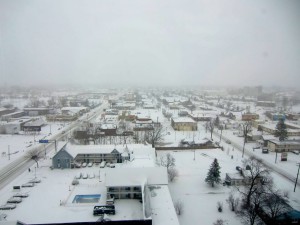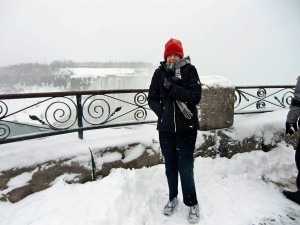IN SEARCH OF SNOW – A DAY AT NIAGARA FALLS
IN SEARCH OF SNOW
This is the eighth in a series of articles about traveling by rail in search of snow
A DAY AT NIAGARA FALLS
By Charles N. Stevens
Photos by Dolores Seidman
Our first look from our hotel window this morning reveals that the world has been transformed. Yesterday’s rain had changed into snow during the night. Snow blows past the parking lot lights, covering every bare space with a coating of fresh fallen fluff. The cars in the lot are decked with white, and snow plows work at clearing the main roads, their amber warning lights blinking. An eerie bluish translucence tints the dawn while all the distant buildings and trees appear ghostly, muted by falling snow. Although we have seen a lot of old snow on the ground, this is the first time we have seen it drifting down. In our search for snow we have finally found it. The bare tree branches contrasting with the new white around them, remind us of scenes on Christmas cards. Cars move slowly through the streets, their lights poking bright holes in the morning. The plows cut through the accumulated slush like a boat through water, shoving it all to the side. Flakes even stick to our window as we watch the magical drama outside.
After a sumptuous buffet breakfast we board our snow-decked bus for a tour around Niagara Falls. It’s hard to leave the hotel lobby with its stonework and beams and its massive fireplace. Outdoors, the tiny snowflakes sifting down are almost like dust, moving this way and that according to the wind currents. Even the fallen snow creeps along the ground like dust, sometimes being swept in swirls and eddies on the road.
Mist billows into the air from Horseshoe Falls then sweeps along like a dense fog. Because of the cottony snow caught in bushes and lining the bare trees and the freezing white landscape, the falls look gray with streaks of white foam. Canada geese forage in the snow, the sky above pearly gray, almost translucent.
Our bus stops at Table Rock where we have a great view of the falls. As the cascading water falls with a resounding roar, we are impressed with all of that energy, overwhelming. The cloud of mist stirred up by the falls rises slowly and drifts down the river. We are careful as we walk in the treacherous footing, the small flakes still whipped by the wind sticking to our clothes. Our guide tells us that the water is 180 feet deep at the bottom of the falls. The Maid of the Mist, the tourist boat that takes people for thrilling rides close to the falls, is docked for the winter, waiting until April or May to begin again.
A plow passes by with its blinking lights, the sound of its blade scraping the street. Snow blows like white smoke off a roof. Near a church a man works to clear a pathway with his shovel.
Our bus becomes mired in the snow as we stop at the whirlpool where the Niagara River makes a 90-degree turn. The snow stops, and the visibility rapidly improves, giving us a clearer picture of the turbulent waters below. We notice that, despite the 23-degree temperature, the gulls are just as active, and determined joggers are still getting their exercise. Our bus has a terrible time getting out of the snow, slipping and sliding as the driver tries to gain access to the main road, the passengers visibly apprehensive. Only after a plow comes to our aid are we able to make traction.
Once our bus frees itself from the slippery surface, we move on to view the American Falls. It’s worth a walk through the slush and snow and the biting wind to admire their beauty. Gray-green water tumbles among boulders festooned with long icicles.
On our way to our next adventure, we leave the falls area and go through American Customs. We have to get off the bus and show our passports, but the process is easy and the officials courteous. Once through the border, we head for the railroad station for the next leg of the trip. On the way I note icicles dangling from a traffic signal while nearby a man tries to scrape away the snow that has accumulated on his car.
We board Amtrak’s “The Maple Leaf” at 12:50, leaving the station under gray skies. From the train window I notice a wrecking yard of old cars softened with snow. There is a strange beauty about it that would never occur on a summer day when it would look like the junk it is. As our train gains speed, snow by the tracks and right of way churned up by the locomotive, flies by our windows. We pass by Lake Erie looking very dark under the dull skies. The train pauses at Buffalo, New York where residential streets are choked with snow and some cars are buried. A continuous winter scene passes by our windows as the train hurtles toward Rochester, New York, where bare trees are covered and a fresh dusting tops dark lake ice. By mid afternoon we come upon the skyline of Rochester, famous for the Kodak Company and its founder, George Eastman. One of the first scenes we see is of a boy sliding down a hill on his sled.
Our train speeds on towards Syracuse. Deer graze in the snow, looking for grass, and geese ride slowly on moving ice shelves that float in a river. As we pass Syracuse and head for Ithaca snow begins to fall again, becoming heavier as we get closer. By the time we arrive in Schenectady, our final destination for the day and the home of giant General Electric, the snow has turned into a gentle rain.
As we leave the train, a yellow school bus waits for us. We jam ourselves into the seats designed for children with our hand luggage balanced on our laps, hoping our trip to the hotel will not be long. We’re glad to be inside again at the cozy Hampton Inn where we enjoy sliders, small tasty hamburgers, and a complimentary glass of wine in the lounge. It had been a long day.
Just before bedtime I peek out the window and see snowflakes drifting past one of the outside lights, looking like a blizzard of moths.

The snowy scene outside our hotel window in the morning is breathtaking!

Even during winter the falls continue their plunge over the precipice.

Our search for snow is answered at Niagara Falls as Dolores tries to keep warm.

Where the Niagara Window bends, turbulent whirlpools swirl.
MONTEREY PARK AUTHOR PUBLISHES 3RD BOOK ABOUT HIS EXPERIENCES IN WORLD WAR II- BACK FROM COMBAT
Charles “Norm” Stevens, a 40 year resident of Monterey Park and World War II Veteran has recently published the 3rd in his series about his experiences in WW II, Back from Combat: A WWII Bombardier Faces His Military Future. This book details the time from when he returned from combat in England where he flew 34 missions over Germany and France until the end of the war. Faced with large numbers of returning combat vets, and not knowing how long the war would continue, the military had to plan for their future. His options were whether to return to combat, become an instructor in the U.S., or receive new training that he would use in the Pacific. The book concludes with the end of the war with an Afterward that includes an update on the B-l7’s still flying in the U.S., as well as present day accounts pertaining to the war.
Stevens is the author of two previous books about his experiences:
An Innocent at Polebrook: A Memoir of an 8th Air Force Bombardier (Story of his 34 bombing missions from his base at Polebrook, England over Germany and France)
The Innocent Cadet: Becoming A World War II Bombardier (A prequel to the first, telling of his training in the U.S. before going overseas into combat.)
He is known to the readers of The Citizen’s Voice as the author of Travel Log Articles including “From Paris to Normandy on the Seine”, “Exploring New York” and “In Search of Snow.” He is retired, having taught for 32 years, primarily in the Montebello Unified School District.
Those interested in purchasing an autographed copy of any of his books may contact the author at 323-721-8230 or Normstevens24@gmail.com.



